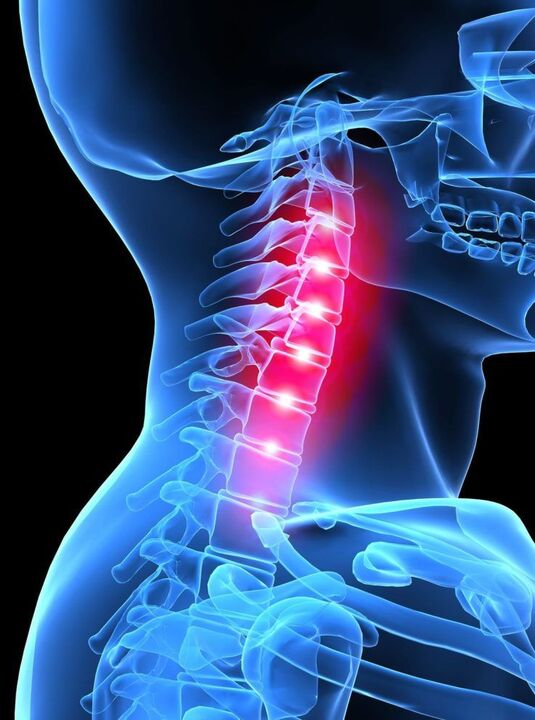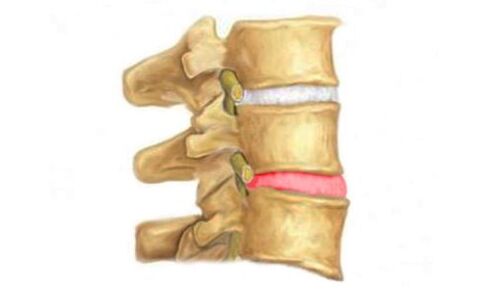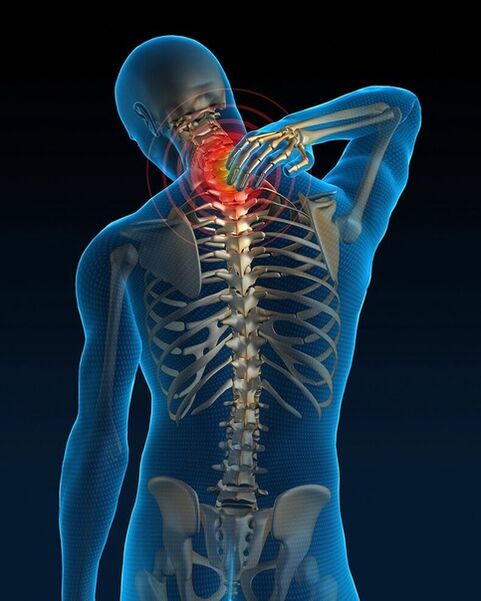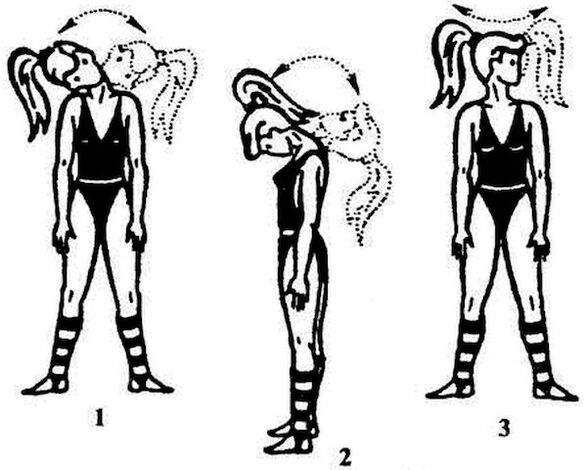
Cervical osteosarcoma is a pathology of the spine, characterized by degeneration of the discs., in the presence of a significant decrease in height, reactive growth of marginal osteocytes, as well as spinal sclerosis.
The vertebrae of the cervical region are close enough to each other. The muscular framework in this area is relatively weakly developed, so cervical spondylosis, even under a light load, also leads to spinal disc deviation, resulting in compression on nerves and blood vessels.
The cartilage tissue of the disc affected by the process of bone resorption gradually turns into and degenerates to form bone. As a result, the discs harden and decrease in size, and eventually lose their cushioning properties between the vertebral discs, putting pressure on the nerve endings, causing more pain.
The discs of the cervical region are a fibrocartilage disc. In the middle of the disc is the nucleus, surrounded by an annulus fibrosus, i. e. tissue resembling tendon fibers. The intervertebral disc does not have a vascular system, and therefore nutrition occurs with the help of other tissues.
An important source of intervertebral discs is the spinal muscles, whose dystrophy leads to the symptoms of osteonecrosis.. During weight lifting, jumping or other physical activities, the shock-absorbing functions of the spine maintain the necessary distance between the vertebrae. The disorder is a disease. Photo below.

I want to emphasize, because protrusions (the main sign of osteonecrosis) are more likely to form in the lumbar spine, and therefore a complication - a herniated disc.
Disc protrusion is a prolapse (protrusion) of the disc without rupture of the capsule.
Outflow of the nucleus pulposus, i. e. rupture of the annulus, is a disc herniation - the final stage of bone degeneration.
Reason for development
- Infection.
- Poisoned.
- Metabolic disease.
- Age changes.
- genetic predisposition.
- Lack of fluids and vitamins in the diet (malnutrition).
- Injury to the spine.
- Overweight.
- Bad ecosystem.
- Posture disorder.
- Rachiocampsis.
- Flat feet.
- A sedentary lifestyle of the body.
- Instability of segments in the spine.
- Staying in an uncomfortable position for a long time (pressure on the disc).
- Frequent jerky movements or changes in body position.
- Overload of the spine due to the use of uncomfortable shoes, such as high heels.
- Do exercise.
- The musculoskeletal system develops unevenly.
- Pregnancy.
- stressful situations.
- Excessive drinking.
- Smoke.
- Hypothermia.
- Long stay in cold environment.
- Foolproof.
Signs and symptoms
Cervical spine tumor has the following symptoms:
- Dizziness, headache. It should be emphasized that in most cases, the signs of cervical osteochondrosis are accompanied by headache. This condition is related to pressure on the vessels of the cervix and head. Usually, these pain symptoms and syndromes cause severe discomfort to a person, reducing performance. Moreover, the headache is more intense with different body movements;
- dizzyappears when the head is turned to the side;
- Pain in chest and armsin the period of osteonecrosis of the neck, very similar to the signs of angina, i. e. burning pain or pressure in the heart. In most cases, hand pain is accompanied by tingling and numbness;
- LumbagoThis is the most common symptom of cervical cancer. An unpleasant sensation similar to a strong pain extending to the fingers of the hand;
- Tongue numbness. The appearance of this symptom of cervical osteonecrosis causes restriction of tongue movement. In this regard, many patients complain of changes in the tone of the vocal cords (they become very rough), as well as the voice.

Diagnose
So, diagnosis and treatment are carried out by medical professionals - chiropractors, orthopedists, neurosurgeons, with the help of imaging examinations of the patientrelated to limited mobility or deformity complaints. Examine the patient in a sitting, lying, standing, resting or immobile position. The degree of damage to the spinal region is determined according to a special scheme.
Determining the location, extent and nature of pain, the increase in tension of the muscles along the spine is done by feeling the spine. Bending, rotating, flexing the body indicates range of motion in the affected area.
In the future, osteonecrosis is diagnosed using MRI, computed tomography, or radiography. Checking the condition of the blood vessels in the cervical region requires the appointment of computed tomography or ultrasound.
The treatment

Cervical osteosarcoma and its complications are treated with conservative methods aimed at eliminating pain syndromes, dysfunction of the spinal roots, as well as preventing the progression of transformations. dystrophy in the structure of the spine. In cases where conservative treatment is ineffective, according to certain indications, surgical (surgery) treatment is carried out, where the volume depends on the clinical manifestations of bone necrosis and the extent of damage.
Treatment of osteonecrosis directly depends on the severity of the disease process, age-related changes, the method of treatment used, the conscientious implementation of the doctor's recommendations and prescriptionstake care of.. Usually, at the beginning of treatment, the pain in the cervical spine will increase, but soon they will be stopped with the use of drugs, physical therapy, as well as performing physical and massage procedures. therapeutic massage.
The most effective result in the treatment of osteonecrosis is the complex treatment of diseases of the musculoskeletal system as a whole.
Exercise
Exercises and exercises to treat cervical vertebrae help reduce pain, strengthen the muscles of the cervical vertebrae, so osteosarcoma reduces the possibility of recurrence.
- Should start witha simple exercise - ten cervical spine rotations without shaking. Gymnastics is performed as follows: the head turns in one direction, and at the same time freezes at a certain point for a few seconds, and then reverses the procedure. While performing, the head should not be lowered, the eyes are directed forward.
- Exercise - tilt your head. The head is tilted to the left to touch the shoulder joint with the ear, and the right shoulder should be kept relaxed. We repeat on the right side. The above exercises restore shock absorption properties. Photo below.
- Neck stretching exercises.We bend the neck and tilt the head back. During the forward movement, the chin is pressed against the chest and held in the same position for a few seconds. As a result, we twist the head back to its original position and tilt it back. The exercises are repeated ten times.

As you can see, the exercises or exercises for the neck are very simple but extremely effective. The main thing is to exercise regularly..
Massage
Osteochondrosis is not a sentence! Drug treatment, massage, therapeutic exercises can all be done at home.
Cervical spine massage with osteoclast method is performed in the presence of someone close to you. Massage oils are used to reduce discomfort.
To perform the procedure, the neck is prepared, so place the patient on a wide surface, and place a folded towel under the shoulder blades.These movements will help stretch the neck muscles and lengthen the spine. For a while, the patient's muscles relax. As a result, the patient sits in a chair with a straight back..
After a certain time, the neck is lubricated with massage oil. The oil takes into account drugs that have a headache-relieving effect. Such oils often contain capsaicin, which heats up when applied, thus creating a comfortable environment at the time of massage.
So, the massage process begins as follows, the trapezius muscle is groped, going from the upper part of the neck down to the shoulders. Knead vigorously enough to feel pressure, but gently, without pain. The muscle of the left side is massaged with the right hand. Each muscle is counted for five minutes, then allowed to rest and repeat again.
The massage is completed by wrapping the area being massaged with a warm towel, after which bed rest is recommended.. Proper massage will cause drowsiness.
























